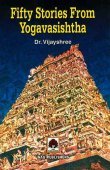Gadhi, Gādhi: 17 definitions
Introduction:
Gadhi means something in Hinduism, Sanskrit, Buddhism, Pali, Marathi, Hindi. If you want to know the exact meaning, history, etymology or English translation of this term then check out the descriptions on this page. Add your comment or reference to a book if you want to contribute to this summary article.
In Hinduism
Purana and Itihasa (epic history)
Source: Wisdom Library: Bhagavata PuranaGādhi (गाधि):—Son of Kuśāmbu (one of the four sons of Kuśa, son of Ajaka). He had a daughter named Satyavatī. He had a son named Viśvāmitra. (see Bhāgavata Purāṇa 9.15.4-5, 9.16.28)
Source: archive.org: Puranic Encyclopedia1) Gādhi (गाधि).—Father of Viśvāmitra. Genealogy. Descended from Viṣṇu thus: Brahmā-Atri-Candra-Budha-Purūravas-Āyus-Nahuṣa-Yayāti Pūru-Janamejaya-Prācinvān-Pravīra-Namasyu-Vītabhaya-Śuṇḍu-Bahuvidha-Saṃyāti-Rahovādi-Raudrāśva-Matināra-Santurodha-Duṣyanta-Bharata (Vitatha)Suhotra-Bṛhatputra-Ajamīḍha-Jahnu-Balākāśva-Kuśika (Kuśa)-Gādhi. Birth. Kuśa had by his wife Vaidarbhī four sons called Kuśāmba, Kuśanābha, Asūrtarajas and Vasu. Of the four sons Kuśāmba built a city called Kauśāmbī, Kuśanābha built the city of Mahodayapura, Asūrtarajas the city of Dharmāraṇya and Vasu the city of Girivraja, and they administered their respective cities. Kuśanābha had hundred daughters by his wife Ghṛtācī, an Apsarā woman. He felt very sad that he had no sons. At last he performed the Putrakāmeṣṭi yajña, and Gādhi was born to him. Gādhi’s children. A son named Viśvāmitra and a daughter called Satyavatī were born to Gādhi. Satyavatī was married to sage Ṛcīka. After the wedding of his daughter Gādhi crowned Viśvāmitra as the king and left for the forest for tapas. During his stay in the forest Gādhi was put up in the āśrama of Ṛcīka for a long time and he also went on many pilgrimages. (Śānti Parva, Chapter 49). (See also Satyavatī and Viśvāmitra. Death. Gādhi entered mahāsamādhi and went to heaven. (Śalya Parva, Chapter 16). (See full article at Story of Gādhi from the Puranic encyclopaedia by Vettam Mani)
2) Gādhi (गाधि).—A brahmin who showed Viṣṇu’s power of māyā. (See under Māyā).
Source: archive.org: Shiva Purana - English TranslationGādhi (गाधि) (or Gāthin) is the father of sage Viśvāmitra, according to the Śivapurāṇa 2.4.3 (“The boyhood sports of Kārttikeya”).—Accordingly, after Śiva’s son spoke to sage Viśvāmitra: “On hearing his words, Gādhi’s son (Viśvāmitra) was highly delighted and surprised. He spoke to him in a tone, by no means highly accented”.
Source: Cologne Digital Sanskrit Dictionaries: The Purana IndexGādhi (गाधि).—(Kauśika) a royal sage who knew the yoga powers of Hari;1 the son of Kuśāmbu(a) (Kuśanābha, Vāyu-purāṇa.) Indra incarnate. His daughter was Satyavatī whom the Brāhmaṇa Ṛcīka wanted to marry. Gādhi thought him unsuitable and asked for a bride-fee of a thousand horses white like the moon and with one ear black. This condition was satisfied with the help of Varuṇa, and Ṛcīka got her married. Gādhi's wife took the consecrated caru intended for her daughter and became the mother of a Brahmavit, by name Viśvāmītra.2 He was desirous of more territory on the earth.3 Son of Kuśika, wife Paurukutsi.4
- 1) Bhāgavata-purāṇa I. 19. 9: II. 7. 44. Vāyu-purāṇa 91. 65-6.
- 2) Bhāgavata-purāṇa IX. 15. 4-10: 16. 28 and 32. Viṣṇu-purāṇa IV. 7. 11-16.
- 3) Bhāgavata-purāṇa XII. 3. 9.
- 4) Brahmāṇḍa-purāṇa III. 66. 35. 58.
Gādhi (गाधि) is a name mentioned in the Mahābhārata (cf. XIII.4) and represents one of the many proper names used for people and places. Note: The Mahābhārata (mentioning Gādhi) is a Sanskrit epic poem consisting of 100,000 ślokas (metrical verses) and is over 2000 years old.

The Purana (पुराण, purāṇas) refers to Sanskrit literature preserving ancient India’s vast cultural history, including historical legends, religious ceremonies, various arts and sciences. The eighteen mahapuranas total over 400,000 shlokas (metrical couplets) and date to at least several centuries BCE.
Languages of India and abroad
Pali-English dictionary
Source: BuddhaSasana: Concise Pali-English Dictionarygādhi : (aor. of gādhati) stood fast; had a firm footing.

Pali is the language of the Tipiṭaka, which is the sacred canon of Theravāda Buddhism and contains much of the Buddha’s speech. Closeley related to Sanskrit, both languages are used interchangeably between religions.
Marathi-English dictionary
Source: DDSA: The Molesworth Marathi and English Dictionarygaḍhī (गढी).—f ( H) A small fort or fortress; a castle. 2 Better gaḍḍī.
Source: DDSA: The Aryabhusan school dictionary, Marathi-Englishgaḍhī (गढी).—f A small fortress, a castle.
Marathi is an Indo-European language having over 70 million native speakers people in (predominantly) Maharashtra India. Marathi, like many other Indo-Aryan languages, evolved from early forms of Prakrit, which itself is a subset of Sanskrit, one of the most ancient languages of the world.
Sanskrit dictionary
Source: DDSA: The practical Sanskrit-English dictionaryGādhi (गाधि).—m. [gādh-in] Name of the father of Viśvā mitra. (He is supposed to have been an incarnation of Indra and born as the son of king Kauśāmba.)
Derivable forms: gādhiḥ (गाधिः).
See also (synonyms): gādhin.
Source: Cologne Digital Sanskrit Dictionaries: Shabda-Sagara Sanskrit-English DictionaryGādhi (गाधि).—m.
(-dhiḥ) The name of a king sovereign of Kanyakubja, father of ViSwamitra.
Source: Cologne Digital Sanskrit Dictionaries: Benfey Sanskrit-English DictionaryGādhi (गाधि).— (for gādhin, q. cf.) m. The father of Viśvāmitra, [Rāmāyaṇa] 1, 35, 3.
Source: Cologne Digital Sanskrit Dictionaries: Cappeller Sanskrit-English DictionaryGādhi (गाधि).—[masculine] = gāthin [masculine]
Source: Cologne Digital Sanskrit Dictionaries: Monier-Williams Sanskrit-English Dictionary1) Gādhi (गाधि):—[from gā] a m. for dhin, [Mahābhārata iii, ix, xii f.; Harivaṃśa; Pāṇini 4-1, 104; Patañjali; Rāmāyaṇa; Bhāgavata-purāṇa]
2) [v.s. ...] m. [plural] the descendants of Gādhi, ix, 16, 32.
3) b dhin, dheya See 3. gā.
Source: Cologne Digital Sanskrit Dictionaries: Yates Sanskrit-English DictionaryGādhi (गाधि):—(dhiḥ) 2. m. The name of a king, father of Viswāmitra.
[Sanskrit to German]
Sanskrit, also spelled संस्कृतम् (saṃskṛtam), is an ancient language of India commonly seen as the grandmother of the Indo-European language family (even English!). Closely allied with Prakrit and Pali, Sanskrit is more exhaustive in both grammar and terms and has the most extensive collection of literature in the world, greatly surpassing its sister-languages Greek and Latin.
Hindi dictionary
Source: DDSA: A practical Hindi-English dictionaryGaḍhī (गढी):—(nf) a keep, fortress.
...
See also (Relevant definitions)
Starts with: Gadhia, Gadhia, Gadhibhu, Gadhichi, Gadhija, Gadhika, Gadhikarana, Gadhike, Gadhin, Gadhinagara, Gadhinandana, Gadhipura, Gadhiputra, Gadhisu, Gadhisunu, Gadhita, Gadhiya, Gadhiya-paisa.
Ends with (+46): Acankati, Ainkati, Akati, Ananniyakati, Apikati, Appiyakati, Ardhamagadhi, Ardhmagadhi, Atokati, Bhogadhi, Cacakati, Cakati, Carakati, Caranakati, Carcukati, Cekati, Civakati, Cupakati, Jakati, Jalajagamdhi.
Full-text (+36): Gadhija, Gadhipura, Gadhibhu, Gadhiputra, Gadhinagara, Gadhinandana, Gadheya, Vishvamitra, Gadhisunu, Makwanpur-gadhi, Gadhin, Kusika, Gathin, Kusamba, Chhanna, Satyavati, Vishvakrit, Ashtaka, Kratuman, Vishvaratha.
Relevant text
Search found 26 books and stories containing Gadhi, Gādhi, Gaḍhī; (plurals include: Gadhis, Gādhis, Gaḍhīs). You can also click to the full overview containing English textual excerpts. Below are direct links for the most relevant articles:
Ramayana (by Manmatha Nath Dutt)
Chapter LVI < [Book 1 - Bāla-kāṇḍa]
Chapter XXXIV < [Book 1 - Bāla-kāṇḍa]
Chapter LI < [Book 1 - Bāla-kāṇḍa]
Manusmriti with the Commentary of Medhatithi (by Ganganatha Jha)
Verse 7.42 < [Section IV - Duties of the King]
Verse 7.41 < [Section IV - Duties of the King]
List of Mahabharata people and places (by Laxman Burdak)
Yoga Vasistha [English], Volume 1-4 (by Vihari-Lala Mitra)
Chapter XLVII - Verification of gadhi’s vision < [Book V - Upasama khanda (upashama khanda)]
Chapter XLIX - Gadhi’s gaining of true knowledge < [Book V - Upasama khanda (upashama khanda)]
Chapter XLVIII - On the wondrous power of illusion < [Book V - Upasama khanda (upashama khanda)]
Ramayana of Valmiki (by Hari Prasad Shastri)
Chapter 34 - Gadhi is the father of Vishvamitra < [Book 1 - Bala-kanda]
Chapter 56 - Shri Vasishtha conquers Vishvamitra < [Book 1 - Bala-kanda]
Chapter 51 - Gautama’s son Shatananda < [Book 1 - Bala-kanda]
Puranic encyclopaedia (by Vettam Mani)
Related products


